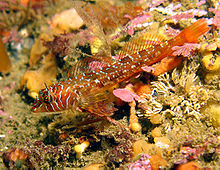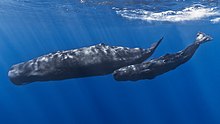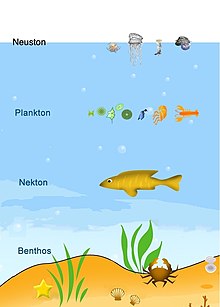

An aquatic animal is any animal, whether vertebrate or invertebrate, that lives in a body of water for all or most of its lifetime. Aquatic animals generally conduct gas exchange in water by extracting dissolved oxygen via specialised respiratory organs called gills, through the skin or across enteral mucosae, although some are evolved from terrestrial ancestors that re-adapted to aquatic environments (e.g. marine reptiles and marine mammals), in which case they actually use lungs to breathe air and are essentially holding their breath when living in water. Some species of gastropod mollusc, such as the eastern emerald sea slug, are even capable of kleptoplastic photosynthesis via endosymbiosis with ingested yellow-green algae.
Almost all aquatic animals reproduce in water, either oviparously or viviparously, and many species routinely migrate between different water bodies during their life cycle. Some animals have fully aquatic life stages (typically as eggs and larvae), while as adults they become terrestrial or semi-aquatic after undergoing metamorphosis. Such examples include amphibians such as frogs, many flying insects such as mosquitoes, mayflies, dragonflies, damselflies and caddisflies, as well as some species of cephalopod molluscs such as the algae octopus (whose larvae are completely planktonic, but adults are highly terrestrial).
Aquatic animals are a diverse polyphyletic group based purely on the natural environments they inhabit, and many morphological and behavioral similarities among them are the result of convergent evolution. They are distinct from terrestrial and semi-aquatic animals, who can survive away from water bodies, while aquatic animals often die of dehydration or hypoxia after prolonged removal out of water due to either gill failure or compressive asphyxia by their own body weight (as in the case of whale beaching). Along with aquatic plants, algae and microbes, aquatic animals form the food webs of various marine, brackish and freshwater aquatic ecosystems.
Description

The term aquatic can be applied to animals that live in either fresh water or salt water. However, the adjective marine is most commonly used for animals that live in saltwater or sometimes brackish water, i.e. in oceans, shallow seas, estuaries, etc.
Aquatic animals can be separated into four main groups according to their positions within the water column.
- Neustons ("floaters"), more specifically the zooneustons, inhabit the surface ecosystem and use buoyancy to stay at the water surface, sometimes with appendages hanging from the underside for foraging (e.g. Portuguese man o' war, chondrophores and the buoy barnacle). They only move around via passive locomotion, meaning they have vagility but no motility.
- Planktons ("drifters"), more specifically the metazoan zooplanktons, are suspended within the water column with no motility (most aquatic larvae) or limited motility (e.g. jellyfish, salps, larvaceans, and escape responses of copepods), causing them to be mostly carried by the water currents.
- Nektons ("swimmers") have active motility that are strong enough to propel and overcome the influence of water currents. These are the aquatic animals most familiar to the common knowledge, as their movements are obvious on the macroscopic scale and the cultivation and harvesting of their biomass is most important to humans as seafoods. Nektons often have powerful tails, paddle/fan-shaped appendages with large wetted surfaces (e.g. fins, flippers or webbed feet) and/or jet propulsion (in the case of cephalopods) to achieve aquatic locomotion.
- Benthos ("bottom dwellers") inhabit the benthic zone at the floor of water bodies, which include both shallow sea (coastal, littoral and neritic) and deep sea communities. These animals include sessile organisms (e.g. sponges, sea anemones, corals, sea pens, sea lilies and sea squirts, some of which are reef-builders crucial to the biodiversity of marine ecosystems), sedentary filter feeders (e.g. bivalve molluscs) and ambush predators (e.g. flatfishes and bobbit worms, who often burrow or camouflage within the marine sediment), and more actively moving bottom feeders who swim (e.g. demersal fishes) and crawl around (e.g. decapod crustaceans, marine chelicerates, octopus, most non-bivalvian molluscs, echinoderms etc.). Many benthic animals are algivores, detrivores and scavengers who are important basal consumers and intermediate recyclers in the marine nitrogen cycle.
Aquatic animals (especially freshwater animals) are often of special concern to conservationists because of the fragility of their environments. Aquatic animals are subject to pressure from overfishing/hunting, destructive fishing, water pollution, acidification, climate change and competition from invasive species. Many aquatic ecosystems are at risk of habitat destruction/fragmentation, which puts aquatic animals at risk as well. Aquatic animals play an important role in the world. The biodiversity of aquatic animals provide food, energy, and even jobs.
Freshwater aquatic animals
Fresh water creates a hypotonic environment for aquatic organisms. This is problematic for organisms with pervious skins and gills, whose cell membranes may rupture if excess water is not excreted. Some protists accomplish this using contractile vacuoles, while freshwater fish excrete excess water via the kidney. Although most aquatic organisms have a limited ability to regulate their osmotic balance and therefore can only live within a narrow range of salinity, diadromous fish have the ability to migrate between fresh and saline water bodies. During these migrations they undergo changes to adapt to the surroundings of the changed salinities; these processes are hormonally controlled. The European eel (Anguilla anguilla) uses the hormone prolactin, while in salmon (Salmo salar) the hormone cortisol plays a key role during this process.
Freshwater molluscs include freshwater snails and freshwater bivalves. Freshwater crustaceans include freshwater shrimps, crabs, crayfish,freshwater pirahnas and copepods.
Air-breathing aquatic animals
In addition to water-breathing animals (e.g. fish, most molluscs, etc.), the term "aquatic animal" can be applied to air-breathing tetrapods who have evolved for aquatic life. The most proliferative extant group are the marine mammals, such as Cetacea (whales, dolphins and porpoises, with some freshwater species) and Sirenia (dugongs and manatees), who are too evolved for aquatic life to survive on land at all (where they will die of beaching), as well as the highly aquatically adapted but land-dwelling pinnipeds (true seals, eared seals and the walrus). The term "aquatic mammal" is also applied to riparian mammals like the river otter (Lontra canadensis) and beavers (family Castoridae), although they are technically semiaquatic or amphibious. Unlike the more common gill-bearing aquatic animals, these air-breathing animals have lungs (which are homologous to the swim bladders in bony fish) and need to surface periodically to change breaths, but their ranges are not restricted by oxygen saturation in water, although salinity changes can still affect their physiology to an extent.
There are also reptilian animals that are highly evolved for life in water, although most extant aquatic reptiles, including crocodilians, turtles, water snakes and the marine iguana, are technically semi-aquatic rather than fully aquatic, and most of them only inhabit freshwater ecosystems. Marine reptiles were once a dominant group of ocean predators that altered the marine fauna during the Mesozoic, although most of them died out during the Cretaceous-Paleogene extinction event and now only the sea turtles (the only remaining descendants of the Mesozoic marine reptiles) and sea snakes (which only evolved during the Cenozoic) remain fully aquatic in saltwater ecosystems.
Amphibians, while still requiring access to water to inhabit, are separated into their own ecological classification. The majority of amphibians — except the order Gymnophiona (caecilians), which are mainly terrestrial burrowers — have a fully aquatic larval form known as tadpoles, but those from the order Anura (frogs and toads) and some of the order Urodela (salamanders) will metamorphosize into lung-bearing and sometimes skin-breathing terrestrial adults, and most of them may return to the water to breed. Axolotl, a Mexican salamander that retains its larval external gills into adulthood, is the only extant amphibian that remains fully aquatic throughout the entire life cycle.
Certain amphibious fish also evolved to breathe air to survive oxygen-deprived waters, such as lungfishes, mudskippers, labyrinth fishes, bichirs, arapaima and walking catfish. Their abilities to breathe atmospheric oxygen are achieved via skin-breathing, enteral respiration, or specialized gill organs such as the labyrinth organ and even primitive lungs (lungfish and bichirs).
Most molluscs have gills, while some freshwater gastropods (e.g. Planorbidae) have evolved pallial lungs and some amphibious species (e.g. Ampullariidae) have both. Many species of octopus have cutaneous respiration that allows them to survive out of water at the intertidal zones, with at least one species (Abdopus aculeatus) being routinely terrestrial hunting crabs among the tidal pools of rocky shores.
Importance
Environmental
Aquatic animals play an important role for the environment as indicator species, as they are particularly sensitive to deterioration in water quality and climate change. Biodiversity of aquatic animals is also an important factor for the sustainability of aquatic ecosystems as it reflects the food web status and the carrying capacity of the local habitats. Many migratory aquatic animals, predominantly forage fish (such as sardines) and euryhaline fish (such as salmon), are keystone species that accumulate and transfer biomass between marine, freshwater and even to terrestrial ecosystems.

Importance to humans
As a food source
Aquatic animals are important to humans as a source of food (i.e. seafood) and as raw material for fodders (e.g. feeder fish and fish meal), pharmaceuticals (e.g. fish oil, krill oil, cytarabine and bryostatin) and various industrial chemicals (e.g. chitin and bioplastics, formerly also whale oil). The harvesting of aquatic animals, especially finfish, shellfish and inkfish, provides direct and indirect employment to the livelihood of over 500 million people in developing countries, and both the fishing industry and aquaculture make up a major component of the primary sector of the economy.
The United Nations Food and Agriculture Organization estimates that global consumption of aquatic animals in 2022 was 185 million tonnes (live weight equivalent), an increase of 4 percent from 2020. The value of the 2022 global trade was estimated at USD 452 billion, comprising USD 157 billion for wild fisheries and USD 296 billion for aquaculture. Of the total 185 million tonnes of aquatic animals produced in 2022, about 164.6 million tonnes (89%) were destined for human consumption, equivalent to an estimated 20.7 kg per capita. The remaining 20.8 million tonnes were destined for non-food uses, to produce mainly fishmeal and fish oil. In 2022, China remained the major producer (36% of the total), followed by India (8%), Indonesia (7%), Vietnam (5%) and Peru (3%).

Total fish production in 2016 reached an all-time high of 171 million tonnes, of which 88% was utilized for direct human consumption, resulting in a record-high per capita consumption of 20.3 kg (45 lb). Since 1961 the annual global growth in fish consumption has been twice as high as population growth. While annual growth of aquaculture has declined in recent years, significant double-digit growth is still recorded in some countries, particularly in Africa and Asia. Overfishing and destructive fishing practices fuelled by commercial incentives have reduced fish stocks beyond sustainable levels in many world regions, causing the fishery industry to maladaptively fishing down the food web. It was estimated in 2014 that global fisheries were adding US$270 billion a year to global GDP, but by full implementation of sustainable fishing, that figure could rise by as much as US$50 billion. UN Food and Agriculture Organization projects world production of aquatic animals to reach 205 million tonnes by 2032.
Where sex-disaggregated data are available, approximately 24 percent of the total workforce were women; of these, 53 percent were employed in the sector on a full-time basis, a great improvement since 1995, when only 32 percent of women were employed full time.
Aquatic animal are highly perishable and several chemical and biological changes take place immediately after death; this can result in spoilage and food safety risks if good handling and preservation practices are not applied all along the supply chain. These practices are based on temperature reduction (chilling and freezing), heat treatment (canning, boiling and smoking), reduction of available water (drying, salting and smoking) and changing of the storage environment (vacuum packing, modified atmosphere packaging and refrigeration). Aquatic animal products also require special facilities such as cold storage and refrigerated transport, and rapid delivery to consumers.
Recreational fishing
In addition to commercial and subsistence fishing, recreational fishing is a popular pastime in both developed and developing countries, and the manufacturing, retail and service sectors associated with recreational fishing have together conglomerated into a multibillion-dollar industry. In 2014 alone, around 11 million saltwater sportfishing participants the United States generated USD$58 billion of retail revenue (comparatively, commercial fishing generated USD$141 billion that same year). In 2021, the total revenue of recreational fishing industry in the United States overtook those of Lockheed Martin, Intel, Chrysler and Google; and together with personnel salary (about USD$39.5 billion) and various tolls and fees collected by fisheries management agencies (about USD$17 billion), contributed almost USD$129 billion to the GDP of the United States, roughly 1% of the national GDP and more than the economic sum of 17 U.S. states.
See also
- Aquatic ecosystem
- Aquatic locomotion
- Aquatic mammal
- Aquatic plant
- Freshwater snail
- Marine biology
- Marine invertebrates
- Marine mammal
- Marine vertebrate
- Terrestrial animal
- Terrestrial ecosystem
- Terrestrial locomotion
- Terrestrial plant
- Wetland – Type of land area that is flooded or saturated with water
- Wetland indicator status
- Zoology
Sources
![]() This article incorporates text from a free content work. Licensed under CC BY 4.0 (license statement/permission). Text taken from The State of World Fisheries and Aquaculture 2024, FAO.
This article incorporates text from a free content work. Licensed under CC BY 4.0 (license statement/permission). Text taken from The State of World Fisheries and Aquaculture 2024, FAO.
References
- Biology Online Dictionary: "Aquatic" Archived 31 May 2009 at the Wayback Machine
- "Protecting Marine Wildlife". The Humane Society of the United States. Retrieved 7 October 2020.
- "World Organisation for Animal Health (OIE)". International Regulatory Co-operation. 2 November 2016. pp. 162–163. doi:10.1787/9789264244047-41-en. ISBN 9789264266254.
- "Vertebrate Kidneys". 3 November 2002. Archived from the original on 29 April 2006. Retrieved 14 May 2006.
- Kalujnaia, S.; et al. (2007). "Salinity adaptation and gene profiling analysis in the European eel (Anguilla anguilla) using microarray technology". Gen. Comp. Endocrinol. 152 (2007): 274–80. doi:10.1016/j.ygcen.2006.12.025. PMID 17324422.
- Bisal, G.A.; Specker, J.L. (24 January 2006). "Cortisol stimulates hypo-osmoregulatory ability in Atlantic salmon, Salmo salar L". Journal of Fish Biology. 39 (3): 421–432. doi:10.1111/j.1095-8649.1991.tb04373.x.
- "Nuôi trồng thủy sản, ngành học với nhiều cơ hội việc làm, đáp ứng nhu cầu xã hội". Archived from the original on 11 November 2016.
- "Từ điển THUẬT NGỮ NUÔI TRỒNG THỦY SẢN của FAO năm 2008" (PDF). Archived from the original (PDF) on 8 January 2016.
- ^ "Ocean Habitat". National Geographic. 31 October 2016. Retrieved 28 October 2020.
- What Is Aquatic Biodiversity; Why Is It Important?. Virginia, US. 2019. p. 2.
{{cite book}}: CS1 maint: location missing publisher (link) - The State of World Fisheries and Aquaculture 2024. FAO. 7 June 2024. doi:10.4060/cd0683en. ISBN 978-92-5-138763-4.
- ^ In brief, The State of World Fisheries and Aquaculture, 2018 (PDF). FAO. 2018.
- C. Michael Hogan (2010) Overfishing, Encyclopedia of earth, topic ed. Sidney Draggan, ed. in chief C. Cleveland, National Council on Science and the Environment (NCSE), Washington, DC
- Fisheries and Aquaculture in our Changing Climate Policy brief of the FAO for the UNFCCC COP-15 in Copenhagen, December 2009.
- "Prince Charles calls for greater sustainability in fisheries". London Mercury. Archived from the original on 14 July 2014. Retrieved 13 July 2014.
- ^ The State of World Fisheries and Aquaculture 2024. FAO. 7 June 2024. doi:10.4060/cd0683en. ISBN 978-92-5-138763-4.
 This article incorporates text from this source, which is available under the CC BY 4.0 license.
This article incorporates text from this source, which is available under the CC BY 4.0 license.
- Hubert, Wayne; Quist, Michael, eds. (2010). Inland Fisheries Management in North America (Third ed.). Bethesda, MD: American Fisheries Society. p. 736. ISBN 978-1-934874-16-5.
- Angling Retains its Mainstream Appeal and Broad Economic Impact-American Sportfishing Association Archived 2008-05-13 at the Wayback Machine
- National Marine Fisheries Service (2014) “Fisheries Economics of the United States 2012” Archived 2022-01-25 at the Wayback Machine pages 6 and 8, NOAA Technical Memorandum NMFS-F/SPO-13.
- ^ "Sportfishing in America - A Reliable Economic Force" (PDF). Archived from the original (PDF) on 27 July 2021. Retrieved 10 April 2022.
| Groups of organisms in aquatic ecosystems | |
|---|---|

